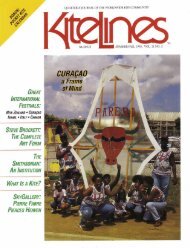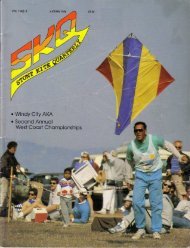You also want an ePaper? Increase the reach of your titles
YUMPU automatically turns print PDFs into web optimized ePapers that Google loves.
Flying withThe Old ProBy Bob IngrahamFounder, American <strong>Kite</strong>fliers AssociationIf you had been flying with the OldPro these past months, you wouldn'thave done much flying or learnedmuch . Due to circumstances beyondmy control, my flying has been limitedmostly to testing and dreamingabout it .One of the reasons during the midsummermonths was the constant threatof thunderstorms which I as a kiteflierfear more than any other weathercondition . This isn't fear for the kitein the air but for the flier far out in theopen and a likely target for lightning .Remember that hazard when you aretempted to go out and fly though thestorm seems far away. Storms oftenmove in fast .One of the few flights I made wasinteresting . Having made a delta ofblack nylon taffeta, I took it along ona short stay at Hawley Lake in northernArizona . The elevation there is 8500feet above sea level . On the lightestof winds (about two to three miles perhour), I sent the delta out about 800feet and about 200 feet in the air, overthe lake . When the wind dropped off,the delta began a long glide towardme with no stall dives, just a long slowglide . I kept the slack line up but didno pulling and the kite came in to landjust in front of me on the grass .I was delighted with the performancebut could assign no reason for it,since the kite was identical in configurationwith all others I've made .The only thing I can believe is thatthe material, which is more porousthan most nylon, might have been astabilizing factor. I built another kitewhich performed the same way . Otherdeltas will glide toward you when thewind stops, but the glide is usually aseries of stall dives .While at the lake, I determined totry flying from a boat . There wasn'tenough wind to launch without rowing,so I had the job of getting the kite inthe air and rowing the boat at the sametime . At a very slow rowing speed,the delta lifted nicely and flight wassustained at a wind speed of about fouror five miles per hour. Then thefun began .Out of nowhere came a big falcon tochallenge my black kite's right to flyover his lake . He made some swiftpasses very close to the kite and wasjoined by about 50 small sharp-wingedbirds which I assumed to be insectcatchers. For about five minutes wehad an aerial dog fight going on overheadwhich everyone around the lakewatched with interest .Since I couldn't row the boat to keepthe kite flying and handle the kiteline at the same time, I didn't stir thekite . I am certain that if I had the kitewould have turned on the birds,showed some fight and created someadditional excitement . My conditionsdictated my limits .One of the most perplexing problemsin making determinationsregarding a kite's ability is thevariables . Regardless of the windvelocity when you launch a kite, therewill be variations for almost everyfoot of rise as the craft climbs to thelimit of its lift capacity. In a recentfriendly argument, a friend insistedthat if you wish to determine how muchweight a kite will lift, all you have todo is add weight until the kite can nolonger rise with it .Offhand this would seem simpleenough, but anyone with kiteflyingexperience knows that the differencesbetween winds at ground level andseveral hundred feet in the air can beconsiderable . Those with calculatingability and engineering knowledgecan arrive at certain determinations,but at best the results remain generaland not specific .It is the real-world factor and theever-changing configuration of mostkites while undergoing confrontationwith variable winds that have madesome kiters abandon a kite as worthlesswhen under different wind conditionsit might prove to be a worthy craft .<strong>Kite</strong> performance cannot be basedon wind velocity alone . There areother factors we seldom consider . Airtemperature is one . I find that coldair supports flight better than warmair. Elevation above sea level can havea slight but positive effect . An anemometeris conclusive in only one respect .It establishes the required groundlevel velocity required to loft a kite .It does nothing to determine what thewind may be 200 or more feet above .Humidity is also a factor . It affectsthe kite's composite parts, makingfabrics heavier or lighter, spars moresusceptible to warping and kite linesheavier or lighter, depending on thepercentage of moisture content of theair in which you fly. Air at highelevations has a lower density, but therange of humidity variation is as greatas elsewhere .There is no doubt that kite performanceis puzzling at times . Onecannot help but wonder way a favoritecraft will fly on a five mile-per-hourwind at one time, serenely and well,and at another time in a slightly betterwind, appear sluggish .Unless you are an old fussbudget, behappy if your kite flies at a reasonableangle most of the time . Avail yourselfof different types of kites, each of whichhas its own advantage under certainatmospheric conditions . And don'tforget that various line weights canadd or detract from performance . Thekite that flew so well on a 30-poundtest line in yesterday's eight mile-perhourwind-and won't today-mightsurprise you if you cut the line weightand give it a chance to contend withlesser winds . 0
















